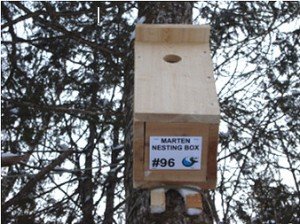 The recovery success story of the wood duck in North America hinged on agencies and volunteers putting up countless nesting boxes to fill a crucial habitat need that was keeping duck densities lower than they could have otherwise been. It worked amazingly well for ducks. Could something similar work for the American marten – a popular furbearer whose numbers have declined in some areas?
The recovery success story of the wood duck in North America hinged on agencies and volunteers putting up countless nesting boxes to fill a crucial habitat need that was keeping duck densities lower than they could have otherwise been. It worked amazingly well for ducks. Could something similar work for the American marten – a popular furbearer whose numbers have declined in some areas?
In random locations throughout the range of marten species in the world, folks are installing nesting boxes in the forest to replace lost habitat and hopefully increase marten numbers.
Habitat is the most critical factor influencing wildlife populations, and furbearers like marten are no exception. Marten need very specific habitat types to survive, including den/nesting sites to raise their young and protect them from predators. Most often marten nest sites consist of a large hollow tree with a small hole carved out of it by a woodpecker. These large, hollow den trees aren’t always abundant, however, and marten can be forced to use poorer nesting sites instead, leading to lower survival.
 Intensively managed forests often lack adequate nesting sites because older trees are harvested before they can rot, die and become cavity, or den trees. Without a bunch of older dying trees, nesting sites for female marten can be scarce. Without an adequate nesting site, an area can become relatively devoid of marten where they otherwise might be abundant. This is where nesting boxes come in.
Intensively managed forests often lack adequate nesting sites because older trees are harvested before they can rot, die and become cavity, or den trees. Without a bunch of older dying trees, nesting sites for female marten can be scarce. Without an adequate nesting site, an area can become relatively devoid of marten where they otherwise might be abundant. This is where nesting boxes come in.
Similar to a duck nesting box, a marten box is a basic constructed cavity with an entry hole just the right size. The box itself can range in size. A typical size starts at 6″x6″, but can be much larger. The entrance hole is round and approximately 2 inches in diameter.
Many trappers and groups have started putting out these boxes and are experimenting with what works and what doesn’t. They are also monitoring how many of the boxes are used. No hard data is available regarding how effective the boxes are and under what conditions they are used, but many trappers swear by them.
See the links below for more information on marten nest boxes:
Marten Nest Boxes – Jean-Guy Ricard
Constructing, Erecting and Monitoring Pine Marten Den Boxes – The Vincent Wildlife Trust
Marten Nesting Box Project – New Brunswick Trappers Association
News Article: Trappers Help With Pine Marten Habitat
Leave a Reply